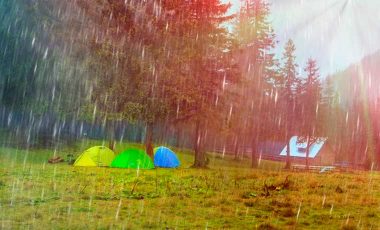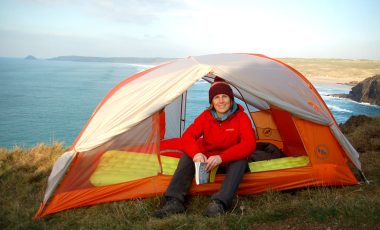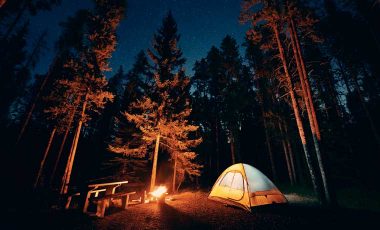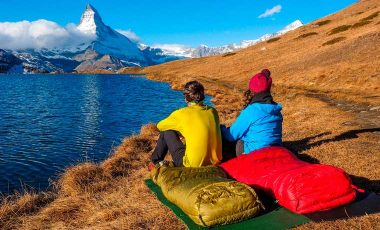There’s something oddly comforting about lying in the warmth of your sleeping bag listening to the rain as it pitter-patters on your tent. But when that pitter-patter turns into a three day onslaught of sideways jet spray, camping in the rain can fast become tiresome, and let’s be honest, downright miserable. When the conditions are that bad, the rain has an uncanny knack of somehow finding its way onto every piece of ‘dry’ gear you have. And all that’s left to do is ride it out in the relative dryness of your tent, or just go home!
How to camp in the rain
No! Don’t go home! There’s still fun to be had. Honestly! A little knowledge on how to camp in the rain goes a very long way, and can turn your washed out weekend into something you might not have expected, but can be loads of fun all the same. Preparation is key, so take a read these super simple tips that will prevent you from drowning in the misery of rainy days at camp.
Clothing and camping gear
Thankfully, almost all outdoor gear is designed to get wet. It might not all be fully waterproof, but when used in the right way, its water resistant properties can be fully maximised to help keep you and your non-waterproof gear stay as dry as possible.
1Bring camp shoes
Whether that’s a pair of flip-flops to squelch around in or some knee high fully waterproof welly boots, having a pair of camp shoes is a must. Ideally they should be easy to slip on and off to keep the water outside of your tent, where is should be. And if they are waterproof, then all the better.
2Waterproof jacket
This is probably the single most important piece of clothing for camping in the rain. Something only water resistant just won’t cut it if the rain is really coming down. So make sure your jacket has a DWR (durable water resistant) coating and has a Gore-tex (or equivalent) lining. It should have a full zip to easily slip on and off, and if possible, vented armpits to keep you from overheating.
3Wear the right pants
If it’s just on and off showers then wearing a pair of quick drying hiking pants may be enough to prevent you from getting soaked through. However, if the rain is there to stay you’ll need a pair of waterproof pants to put over the top of your hiking pants. Like your jacket, they should have a DWR coating and ideally have a Gore-tex lining. They will be most useful if they have zippers at the bottom to allow you to easily take them on and off over your shoes or boots.
4Treat your waterproofs before you go
As mentioned, your waterproofs should have a DWR coating. With time and use, this coating will become less effective and less water repellent. Thankfully, a simple wash with a Nikwax treatment can bring your waterproofs back to their former glory without having to shell out for new gear.
5Don’t wear cotton
No matter how great your waterproofs are, if the rain is relentless, it’s highly likely that some of your clothes will get a little damp, at best. So avoid wearing cotton at all costs. It may be dead comfortable, but as soon as it gets damp it is really hard to dry. It holds water for a long time and can soon cool your body down to a chill. Instead wear base layers that are made from synthetic fabrics that wick away moisture from your body or the water from your jacket, and then dry really speedily.
6Always have spare socks
Looking after your feet can become somewhat challenging in wet conditions. So it’s key to make sure you have spare socks ready to get into at the end of the day. And of course it’s paramount that you keep those spares dry! Store them in their own dry bag if necessary and then just before you turn in for the night, put them inside your sleeping bag to warm them up. Toastie toes!
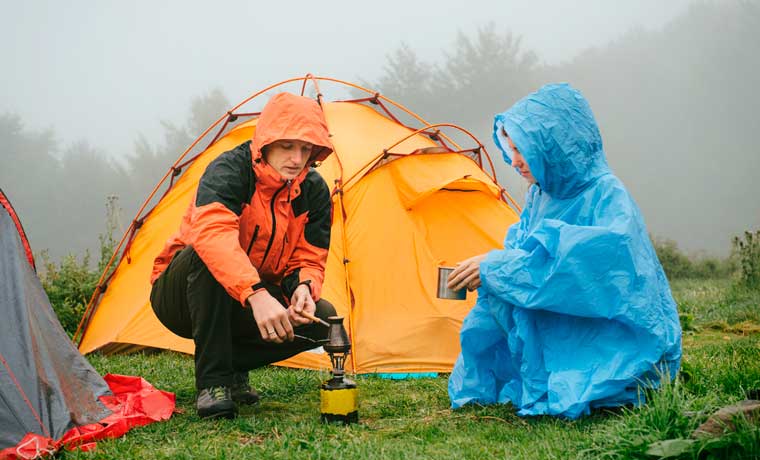
7Use dry bags
Having spare clothing that is totally dry is a real morale boost at the end of a day out in the rain. And like your spare socks, they should be kept in a dry bag, inside your backpack or bag, and inside your tent. You should also keep your sleeping bag inside a dry bag too, especially if it is a down bag which loses its insulation when wet. You may find this read on down vs synthetic useful if you think camping in the rain will be a frequent occurrence.
8Stay damp during the day
So long as you are able to stay warm by moving around lots and eating lots of hot food, it’s often a good idea to stick it out in your slightly damp clothing until it’s time to go to bed. Having totally dry stuff to sleep in is essential and you’ll be much happier for the good nights sleep. However if you are starting to get cold during the day then you may need to change into your dry stuff. If you are car camping then you can bring more clothing and this won’t be a problem.
9Hang your clothes up to dry overnight
It may be tempting to just dump your wet clothes in a bag and forget about them until you get home, but if you have limited clothing then you’ll need to get your damp clothes as dry as possible overnight. Most tents have gear loops in the ceiling that allow you to set up a line to hang out your damp clothes and socks.
10Leave your outer gear in the porch
Your wet waterproofs and boots should stay out of your inner tent if at all possible. Not only will this stop your dry gear from getting wet, but it also prevents condensation from building up inside your tent. Instead, hang them up in your tent porch or vestibule to drip dry overnight. Likewise, if your backpack is soaked, then take its contents (which is hopefully inside dry bags) with you inside the inner tent and leave the empty bag to dry out in the porch.
11Fill your boots with newspaper
If you’ve been out and about all day in the rain, then it’s likely that your hiking boots will have become soggy inside. Leave your boots in your tent porch overnight to dry out with a load of scrunched up newspaper inside them. The newspaper soaks up the water inside the boots and leaves you with a much more pleasant experience in the morning.
12Bring plastic bags
At some point your clothes may go past the point of becoming dry again. So have a few plastic bags at the ready to keep your saturated stuff separate from your dry stuff.

Your tent
Most modern tents do a very good job at stopping the rain from getting in, no matter how horizontal it is. But some tents can only take so much of a battering from the elements. These tips will help you get the most out of what your tent offers to hopefully prolong its weather protection for as long as the rain keeps falling.
13Find high ground
Where possible, you need to avoid pitching your tent near to any water and away from the bottom of a slope. Water will start to pool in dips and towards the bottom of hills and slopes, and you don’t want to wake up floating on a couple of inches of water in the middle of the night! So seek out some high ground where the groundwater will only be flowing away from you (downhill). If you are in a narrow valley or canyon then you need to get out and get up high. Flash floods can happen incredibly quickly. Even if there’s not been loads of rain where you are camping, there may be much more rain further up stream that will be making its way to you before you know it.
14Don’t camp under a tree
During heavy rain trees do a decent job at providing a little extra protection from the downpour. But as soon as the rain stops, the tree will keep dripping for hours. It will also prevent any sun from getting to your tent to help dry things out. So avoid getting lured into their false protection and instead find a spot near some rocks or bushes to gain some protection.
15Position your tent correctly
Before you set up your tent, position it so that the door faces away from the wind. By doing this, you will minimise the amount of rain that will get into your tent each time you open the door. To help with this even more, try to only go into your tent when you really need to, and when you do make a big effort to get in and out quickly!
16Dig a trench around the tent
If you find yourself in a situation where groundwater is starting to pool near your tent, get your shovel out and get digging! Turn your tent into a castle and dig a small moat around its perimeter. Make sure you also dig a channel that takes your moat water away from your tent once the trench becomes full.
17Put a groundsheet down inside your tent
If you have a footprint or groundsheet for your tent, don’t use it directly on the ground. Water can easily pool on top of it and then end up between your tent and the groundsheet causing unnecessary sogginess. Instead use it as a layer of protection from the damp and cold floor by laying it down inside your tent between your tent floor and your sleeping pad.
18Stake out your tent well
To prevent water from pooling on top of your tent, you will need to eliminate any sagginess and create tension across the fly sheet. Use all the stakes you have and securely draw the fly away from the inner where you can. Even if it’s not windy, take the time to secure your guy lines too to help maintain this tension as the fly becomes saturated.
19Don’t touch the sides of the tent
Canvas tents and many cheaper tents are only waterproof to a certain extent. As soon as you touch the sides of the tent, from the inside or the outside, the water can start to seep through the fabric and then drip into the tent. If you have a small tent, you will need to move around inside very carefully to avoid unnecessary contact. Once you are settled in it’s also important to ensure that none of your stuff is touching the edges or sides of the tent.
20Let some air in
No matter how cold it is, it is essential to open the vents on your tent. The air flow will help prevent a buildup of condensation that can quickly start to drip on you and all your stuff that you’ve worked so hard to keep dry!

Around camp
So far it all sounds a little like survival and not that much fun at all. Well yes, but all that work to stay dry and warm will mean happier campers right? Well yes, but happy doing what? Happy camping of course! After all, isn’t camping all about sitting round the fire roasting marshmallows and telling far-fetched stories of past adventures? Set up your camp properly and all of this can still be done, even in the rain.
21Set up a tarp
Having a communal (and dry) place to hang out in will make the world of difference to your enjoyment of camping in the rain. A big tarp that is set up properly enables you to sit around as a group to cook and spend time together. Make sure you position it so that the drips run off and away from your stuff, and remember to gently tip out any pooling water on the roof every now and then.
22Get cooking
Having open flames under a tarp is a no go. But a wood burning stove will be totally fine so long as it isn’t too close to the tarp. Aside from the ability to cook hearty hot camping meals on the stove, the fire will also put out some good heat to help you stay warm and toast your marshmallows on. An instant morale booster. If you don’t have a wood burner, then a gas stove will be fine if kept away from the canopy.
23Stay entertained
Keeping good chat going for hours when morale is a little low can be challenging. So get the cards out and put in some serious rainy day game time. The hours will fly by with the odd hot chocolate interlude every now and then, and before you know it you’ll be having as good a time as during any camping trip. Just more relaxed!
24Get tuned in
Bust out a guitar and once the games have run their course, up the tempo with some campfire songs. Let the raindrops that are falling on your head spark some musical genius to write your own songs. It really doesn’t matter how good they are – but you’ll have great fun doing it and will remember the day forever.
25Get into a good book
If you’re not getting inspired by being outside when it’s raining, then read about it instead. There are thousands of great adventure books out there to get into. And what better place to let them consume you than snuggled up in a (hopefully) dry sleeping bag with the pitter-patter as your soundtrack?
So there you have it! A bit of water falling from the sky doesn’t have to ruin your time outdoors. And yes, camping in the rain can actually be fun. So long as you are prepared, have stuff to keep you entertained, and are ready for a slower than usual style of camping, you’ll never need to cancel camping for bad weather again.


